Research Design Project 2: Sustainable Impact of Motorway Construction
VerifiedAdded on 2022/09/28
|17
|4719
|16
Report
AI Summary
This report analyzes the multifaceted impacts of motorway construction in urban areas and China's strategy of creating megacities. The first part of the report delves into the economic, social, and environmental consequences of building motorways through urban environments. It explores the creation of jobs, improved transportation, and potential economic growth alongside negative impacts such as environmental degradation, noise pollution, and social issues like increased crime. The second part of the report evaluates China's approach to developing megacities, particularly the Pearl River Delta project. It examines the integration of resources, potential for sustainable energy practices, and efficiency gains through dense transportation networks. However, the report also highlights the environmental hazards associated with megacities, including pollution and the risk of flooding. The report concludes by emphasizing the need for stakeholders to enhance positive impacts while mitigating negative environmental and social consequences.

Student Last Name 1
Research Design Project 2
By (Name)
Course
Professor
University
Date
Research Design Project 2
By (Name)
Course
Professor
University
Date
Paraphrase This Document
Need a fresh take? Get an instant paraphrase of this document with our AI Paraphraser
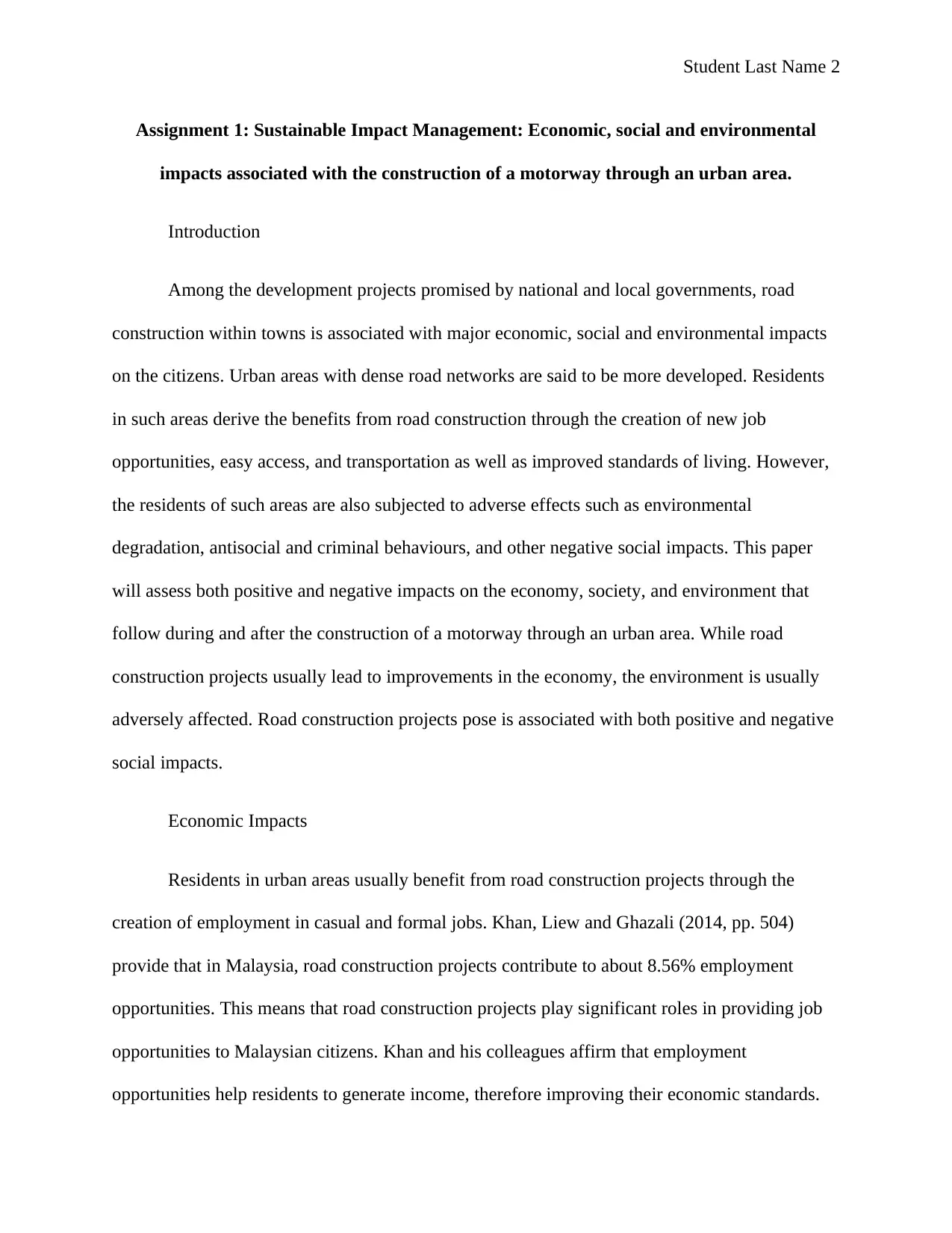
Student Last Name 2
Assignment 1: Sustainable Impact Management: Economic, social and environmental
impacts associated with the construction of a motorway through an urban area.
Introduction
Among the development projects promised by national and local governments, road
construction within towns is associated with major economic, social and environmental impacts
on the citizens. Urban areas with dense road networks are said to be more developed. Residents
in such areas derive the benefits from road construction through the creation of new job
opportunities, easy access, and transportation as well as improved standards of living. However,
the residents of such areas are also subjected to adverse effects such as environmental
degradation, antisocial and criminal behaviours, and other negative social impacts. This paper
will assess both positive and negative impacts on the economy, society, and environment that
follow during and after the construction of a motorway through an urban area. While road
construction projects usually lead to improvements in the economy, the environment is usually
adversely affected. Road construction projects pose is associated with both positive and negative
social impacts.
Economic Impacts
Residents in urban areas usually benefit from road construction projects through the
creation of employment in casual and formal jobs. Khan, Liew and Ghazali (2014, pp. 504)
provide that in Malaysia, road construction projects contribute to about 8.56% employment
opportunities. This means that road construction projects play significant roles in providing job
opportunities to Malaysian citizens. Khan and his colleagues affirm that employment
opportunities help residents to generate income, therefore improving their economic standards.
Assignment 1: Sustainable Impact Management: Economic, social and environmental
impacts associated with the construction of a motorway through an urban area.
Introduction
Among the development projects promised by national and local governments, road
construction within towns is associated with major economic, social and environmental impacts
on the citizens. Urban areas with dense road networks are said to be more developed. Residents
in such areas derive the benefits from road construction through the creation of new job
opportunities, easy access, and transportation as well as improved standards of living. However,
the residents of such areas are also subjected to adverse effects such as environmental
degradation, antisocial and criminal behaviours, and other negative social impacts. This paper
will assess both positive and negative impacts on the economy, society, and environment that
follow during and after the construction of a motorway through an urban area. While road
construction projects usually lead to improvements in the economy, the environment is usually
adversely affected. Road construction projects pose is associated with both positive and negative
social impacts.
Economic Impacts
Residents in urban areas usually benefit from road construction projects through the
creation of employment in casual and formal jobs. Khan, Liew and Ghazali (2014, pp. 504)
provide that in Malaysia, road construction projects contribute to about 8.56% employment
opportunities. This means that road construction projects play significant roles in providing job
opportunities to Malaysian citizens. Khan and his colleagues affirm that employment
opportunities help residents to generate income, therefore improving their economic standards.
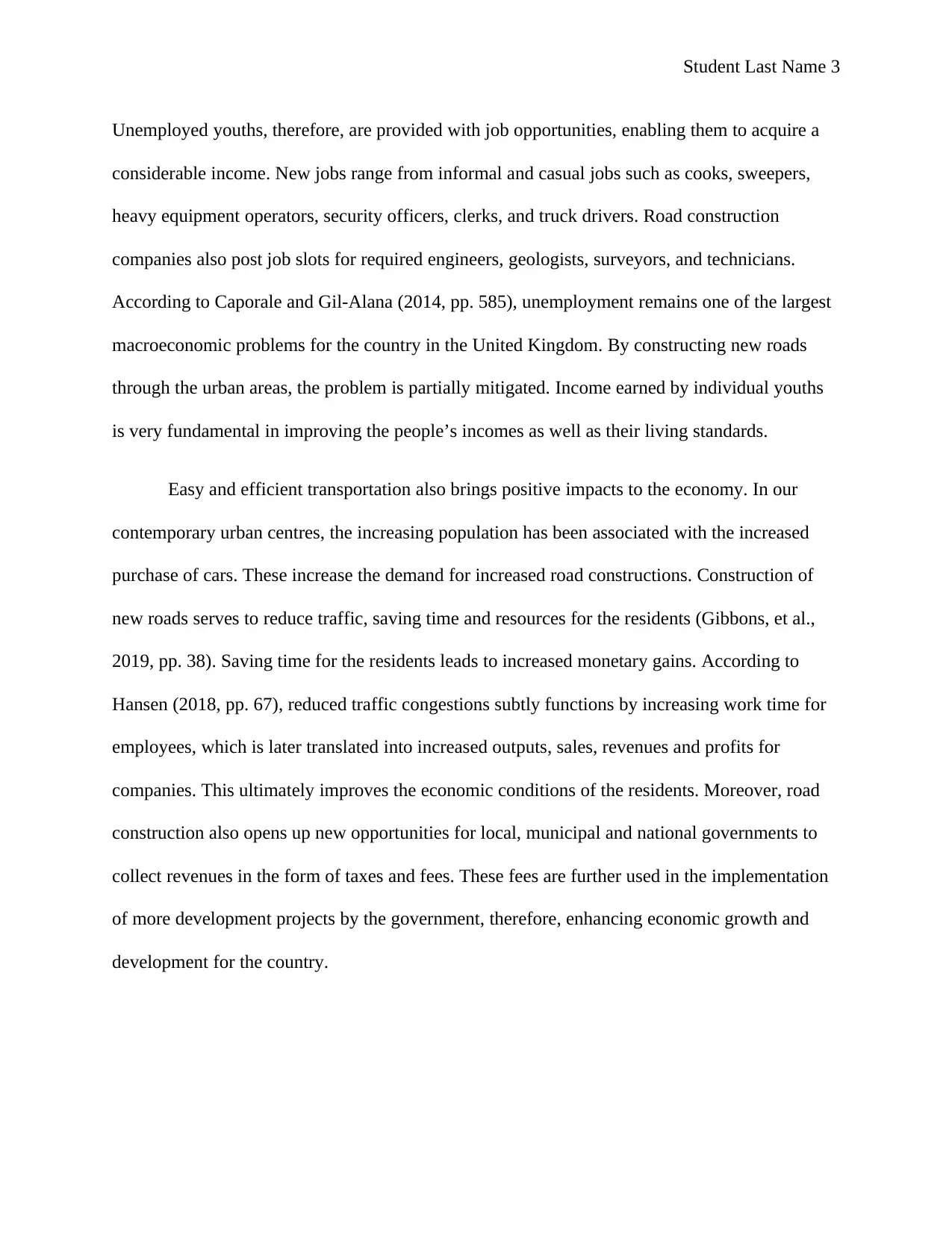
Student Last Name 3
Unemployed youths, therefore, are provided with job opportunities, enabling them to acquire a
considerable income. New jobs range from informal and casual jobs such as cooks, sweepers,
heavy equipment operators, security officers, clerks, and truck drivers. Road construction
companies also post job slots for required engineers, geologists, surveyors, and technicians.
According to Caporale and Gil-Alana (2014, pp. 585), unemployment remains one of the largest
macroeconomic problems for the country in the United Kingdom. By constructing new roads
through the urban areas, the problem is partially mitigated. Income earned by individual youths
is very fundamental in improving the people’s incomes as well as their living standards.
Easy and efficient transportation also brings positive impacts to the economy. In our
contemporary urban centres, the increasing population has been associated with the increased
purchase of cars. These increase the demand for increased road constructions. Construction of
new roads serves to reduce traffic, saving time and resources for the residents (Gibbons, et al.,
2019, pp. 38). Saving time for the residents leads to increased monetary gains. According to
Hansen (2018, pp. 67), reduced traffic congestions subtly functions by increasing work time for
employees, which is later translated into increased outputs, sales, revenues and profits for
companies. This ultimately improves the economic conditions of the residents. Moreover, road
construction also opens up new opportunities for local, municipal and national governments to
collect revenues in the form of taxes and fees. These fees are further used in the implementation
of more development projects by the government, therefore, enhancing economic growth and
development for the country.
Unemployed youths, therefore, are provided with job opportunities, enabling them to acquire a
considerable income. New jobs range from informal and casual jobs such as cooks, sweepers,
heavy equipment operators, security officers, clerks, and truck drivers. Road construction
companies also post job slots for required engineers, geologists, surveyors, and technicians.
According to Caporale and Gil-Alana (2014, pp. 585), unemployment remains one of the largest
macroeconomic problems for the country in the United Kingdom. By constructing new roads
through the urban areas, the problem is partially mitigated. Income earned by individual youths
is very fundamental in improving the people’s incomes as well as their living standards.
Easy and efficient transportation also brings positive impacts to the economy. In our
contemporary urban centres, the increasing population has been associated with the increased
purchase of cars. These increase the demand for increased road constructions. Construction of
new roads serves to reduce traffic, saving time and resources for the residents (Gibbons, et al.,
2019, pp. 38). Saving time for the residents leads to increased monetary gains. According to
Hansen (2018, pp. 67), reduced traffic congestions subtly functions by increasing work time for
employees, which is later translated into increased outputs, sales, revenues and profits for
companies. This ultimately improves the economic conditions of the residents. Moreover, road
construction also opens up new opportunities for local, municipal and national governments to
collect revenues in the form of taxes and fees. These fees are further used in the implementation
of more development projects by the government, therefore, enhancing economic growth and
development for the country.
⊘ This is a preview!⊘
Do you want full access?
Subscribe today to unlock all pages.

Trusted by 1+ million students worldwide
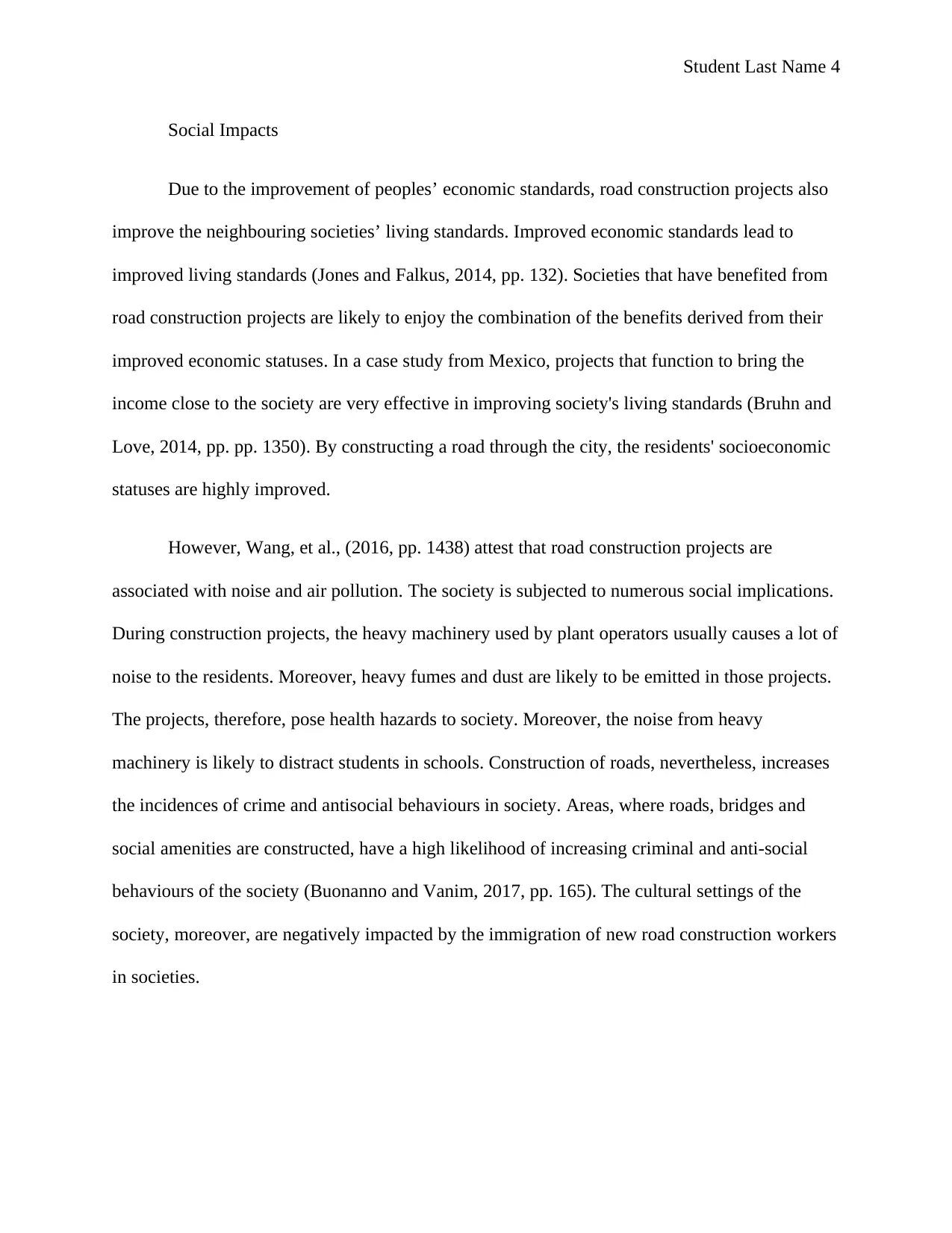
Student Last Name 4
Social Impacts
Due to the improvement of peoples’ economic standards, road construction projects also
improve the neighbouring societies’ living standards. Improved economic standards lead to
improved living standards (Jones and Falkus, 2014, pp. 132). Societies that have benefited from
road construction projects are likely to enjoy the combination of the benefits derived from their
improved economic statuses. In a case study from Mexico, projects that function to bring the
income close to the society are very effective in improving society's living standards (Bruhn and
Love, 2014, pp. pp. 1350). By constructing a road through the city, the residents' socioeconomic
statuses are highly improved.
However, Wang, et al., (2016, pp. 1438) attest that road construction projects are
associated with noise and air pollution. The society is subjected to numerous social implications.
During construction projects, the heavy machinery used by plant operators usually causes a lot of
noise to the residents. Moreover, heavy fumes and dust are likely to be emitted in those projects.
The projects, therefore, pose health hazards to society. Moreover, the noise from heavy
machinery is likely to distract students in schools. Construction of roads, nevertheless, increases
the incidences of crime and antisocial behaviours in society. Areas, where roads, bridges and
social amenities are constructed, have a high likelihood of increasing criminal and anti-social
behaviours of the society (Buonanno and Vanim, 2017, pp. 165). The cultural settings of the
society, moreover, are negatively impacted by the immigration of new road construction workers
in societies.
Social Impacts
Due to the improvement of peoples’ economic standards, road construction projects also
improve the neighbouring societies’ living standards. Improved economic standards lead to
improved living standards (Jones and Falkus, 2014, pp. 132). Societies that have benefited from
road construction projects are likely to enjoy the combination of the benefits derived from their
improved economic statuses. In a case study from Mexico, projects that function to bring the
income close to the society are very effective in improving society's living standards (Bruhn and
Love, 2014, pp. pp. 1350). By constructing a road through the city, the residents' socioeconomic
statuses are highly improved.
However, Wang, et al., (2016, pp. 1438) attest that road construction projects are
associated with noise and air pollution. The society is subjected to numerous social implications.
During construction projects, the heavy machinery used by plant operators usually causes a lot of
noise to the residents. Moreover, heavy fumes and dust are likely to be emitted in those projects.
The projects, therefore, pose health hazards to society. Moreover, the noise from heavy
machinery is likely to distract students in schools. Construction of roads, nevertheless, increases
the incidences of crime and antisocial behaviours in society. Areas, where roads, bridges and
social amenities are constructed, have a high likelihood of increasing criminal and anti-social
behaviours of the society (Buonanno and Vanim, 2017, pp. 165). The cultural settings of the
society, moreover, are negatively impacted by the immigration of new road construction workers
in societies.
Paraphrase This Document
Need a fresh take? Get an instant paraphrase of this document with our AI Paraphraser
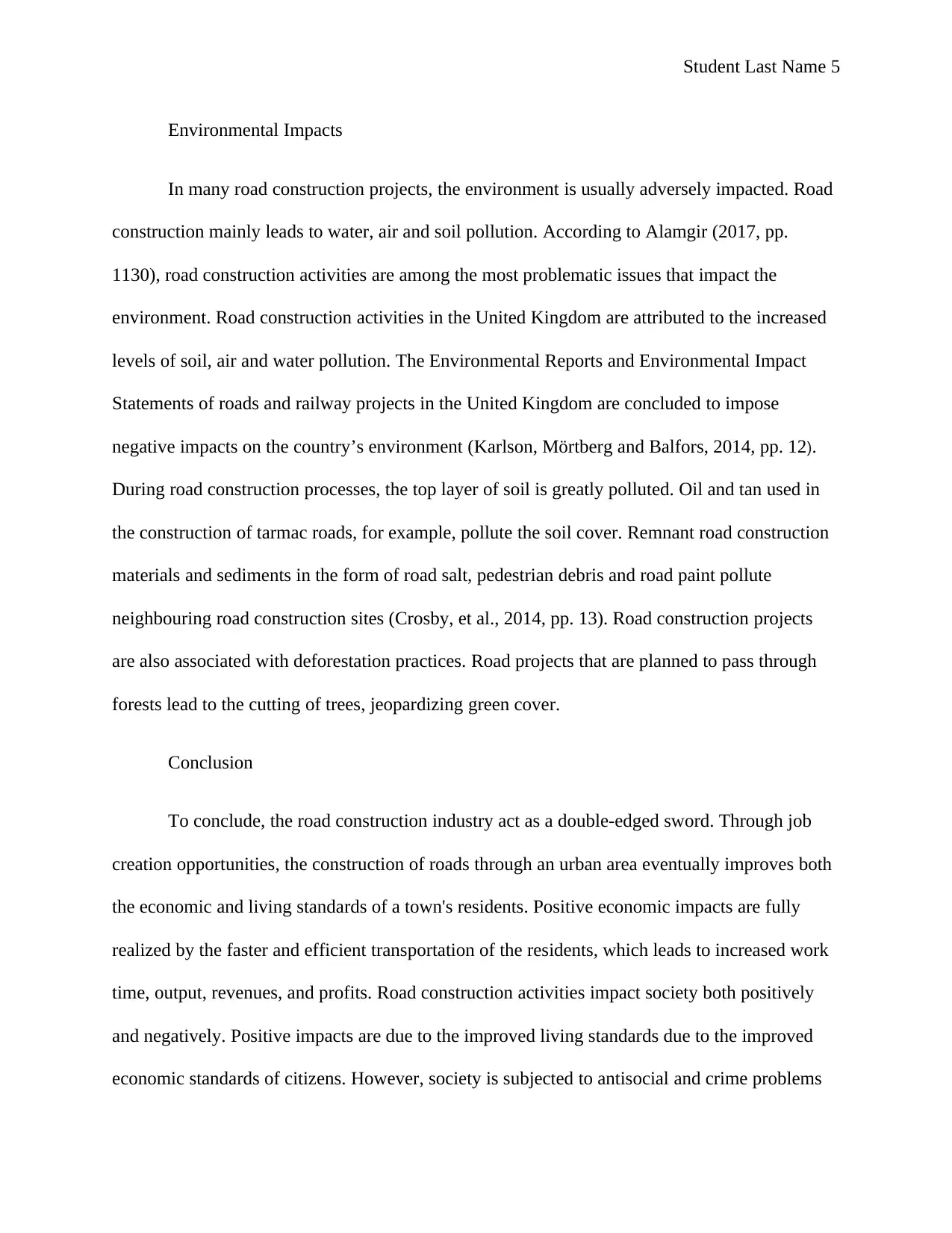
Student Last Name 5
Environmental Impacts
In many road construction projects, the environment is usually adversely impacted. Road
construction mainly leads to water, air and soil pollution. According to Alamgir (2017, pp.
1130), road construction activities are among the most problematic issues that impact the
environment. Road construction activities in the United Kingdom are attributed to the increased
levels of soil, air and water pollution. The Environmental Reports and Environmental Impact
Statements of roads and railway projects in the United Kingdom are concluded to impose
negative impacts on the country’s environment (Karlson, Mörtberg and Balfors, 2014, pp. 12).
During road construction processes, the top layer of soil is greatly polluted. Oil and tan used in
the construction of tarmac roads, for example, pollute the soil cover. Remnant road construction
materials and sediments in the form of road salt, pedestrian debris and road paint pollute
neighbouring road construction sites (Crosby, et al., 2014, pp. 13). Road construction projects
are also associated with deforestation practices. Road projects that are planned to pass through
forests lead to the cutting of trees, jeopardizing green cover.
Conclusion
To conclude, the road construction industry act as a double-edged sword. Through job
creation opportunities, the construction of roads through an urban area eventually improves both
the economic and living standards of a town's residents. Positive economic impacts are fully
realized by the faster and efficient transportation of the residents, which leads to increased work
time, output, revenues, and profits. Road construction activities impact society both positively
and negatively. Positive impacts are due to the improved living standards due to the improved
economic standards of citizens. However, society is subjected to antisocial and crime problems
Environmental Impacts
In many road construction projects, the environment is usually adversely impacted. Road
construction mainly leads to water, air and soil pollution. According to Alamgir (2017, pp.
1130), road construction activities are among the most problematic issues that impact the
environment. Road construction activities in the United Kingdom are attributed to the increased
levels of soil, air and water pollution. The Environmental Reports and Environmental Impact
Statements of roads and railway projects in the United Kingdom are concluded to impose
negative impacts on the country’s environment (Karlson, Mörtberg and Balfors, 2014, pp. 12).
During road construction processes, the top layer of soil is greatly polluted. Oil and tan used in
the construction of tarmac roads, for example, pollute the soil cover. Remnant road construction
materials and sediments in the form of road salt, pedestrian debris and road paint pollute
neighbouring road construction sites (Crosby, et al., 2014, pp. 13). Road construction projects
are also associated with deforestation practices. Road projects that are planned to pass through
forests lead to the cutting of trees, jeopardizing green cover.
Conclusion
To conclude, the road construction industry act as a double-edged sword. Through job
creation opportunities, the construction of roads through an urban area eventually improves both
the economic and living standards of a town's residents. Positive economic impacts are fully
realized by the faster and efficient transportation of the residents, which leads to increased work
time, output, revenues, and profits. Road construction activities impact society both positively
and negatively. Positive impacts are due to the improved living standards due to the improved
economic standards of citizens. However, society is subjected to antisocial and crime problems
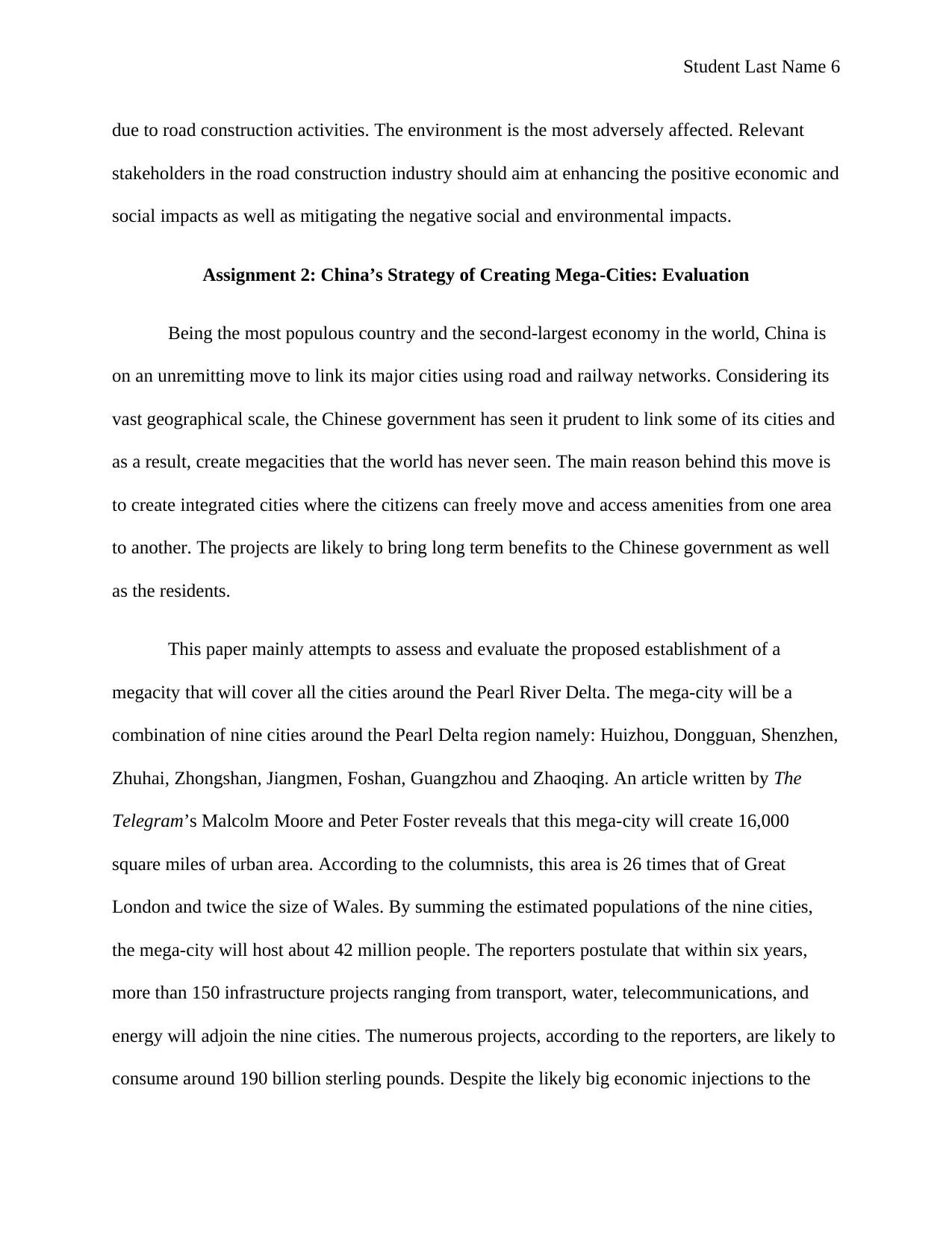
Student Last Name 6
due to road construction activities. The environment is the most adversely affected. Relevant
stakeholders in the road construction industry should aim at enhancing the positive economic and
social impacts as well as mitigating the negative social and environmental impacts.
Assignment 2: China’s Strategy of Creating Mega-Cities: Evaluation
Being the most populous country and the second-largest economy in the world, China is
on an unremitting move to link its major cities using road and railway networks. Considering its
vast geographical scale, the Chinese government has seen it prudent to link some of its cities and
as a result, create megacities that the world has never seen. The main reason behind this move is
to create integrated cities where the citizens can freely move and access amenities from one area
to another. The projects are likely to bring long term benefits to the Chinese government as well
as the residents.
This paper mainly attempts to assess and evaluate the proposed establishment of a
megacity that will cover all the cities around the Pearl River Delta. The mega-city will be a
combination of nine cities around the Pearl Delta region namely: Huizhou, Dongguan, Shenzhen,
Zhuhai, Zhongshan, Jiangmen, Foshan, Guangzhou and Zhaoqing. An article written by The
Telegram’s Malcolm Moore and Peter Foster reveals that this mega-city will create 16,000
square miles of urban area. According to the columnists, this area is 26 times that of Great
London and twice the size of Wales. By summing the estimated populations of the nine cities,
the mega-city will host about 42 million people. The reporters postulate that within six years,
more than 150 infrastructure projects ranging from transport, water, telecommunications, and
energy will adjoin the nine cities. The numerous projects, according to the reporters, are likely to
consume around 190 billion sterling pounds. Despite the likely big economic injections to the
due to road construction activities. The environment is the most adversely affected. Relevant
stakeholders in the road construction industry should aim at enhancing the positive economic and
social impacts as well as mitigating the negative social and environmental impacts.
Assignment 2: China’s Strategy of Creating Mega-Cities: Evaluation
Being the most populous country and the second-largest economy in the world, China is
on an unremitting move to link its major cities using road and railway networks. Considering its
vast geographical scale, the Chinese government has seen it prudent to link some of its cities and
as a result, create megacities that the world has never seen. The main reason behind this move is
to create integrated cities where the citizens can freely move and access amenities from one area
to another. The projects are likely to bring long term benefits to the Chinese government as well
as the residents.
This paper mainly attempts to assess and evaluate the proposed establishment of a
megacity that will cover all the cities around the Pearl River Delta. The mega-city will be a
combination of nine cities around the Pearl Delta region namely: Huizhou, Dongguan, Shenzhen,
Zhuhai, Zhongshan, Jiangmen, Foshan, Guangzhou and Zhaoqing. An article written by The
Telegram’s Malcolm Moore and Peter Foster reveals that this mega-city will create 16,000
square miles of urban area. According to the columnists, this area is 26 times that of Great
London and twice the size of Wales. By summing the estimated populations of the nine cities,
the mega-city will host about 42 million people. The reporters postulate that within six years,
more than 150 infrastructure projects ranging from transport, water, telecommunications, and
energy will adjoin the nine cities. The numerous projects, according to the reporters, are likely to
consume around 190 billion sterling pounds. Despite the likely big economic injections to the
⊘ This is a preview!⊘
Do you want full access?
Subscribe today to unlock all pages.

Trusted by 1+ million students worldwide
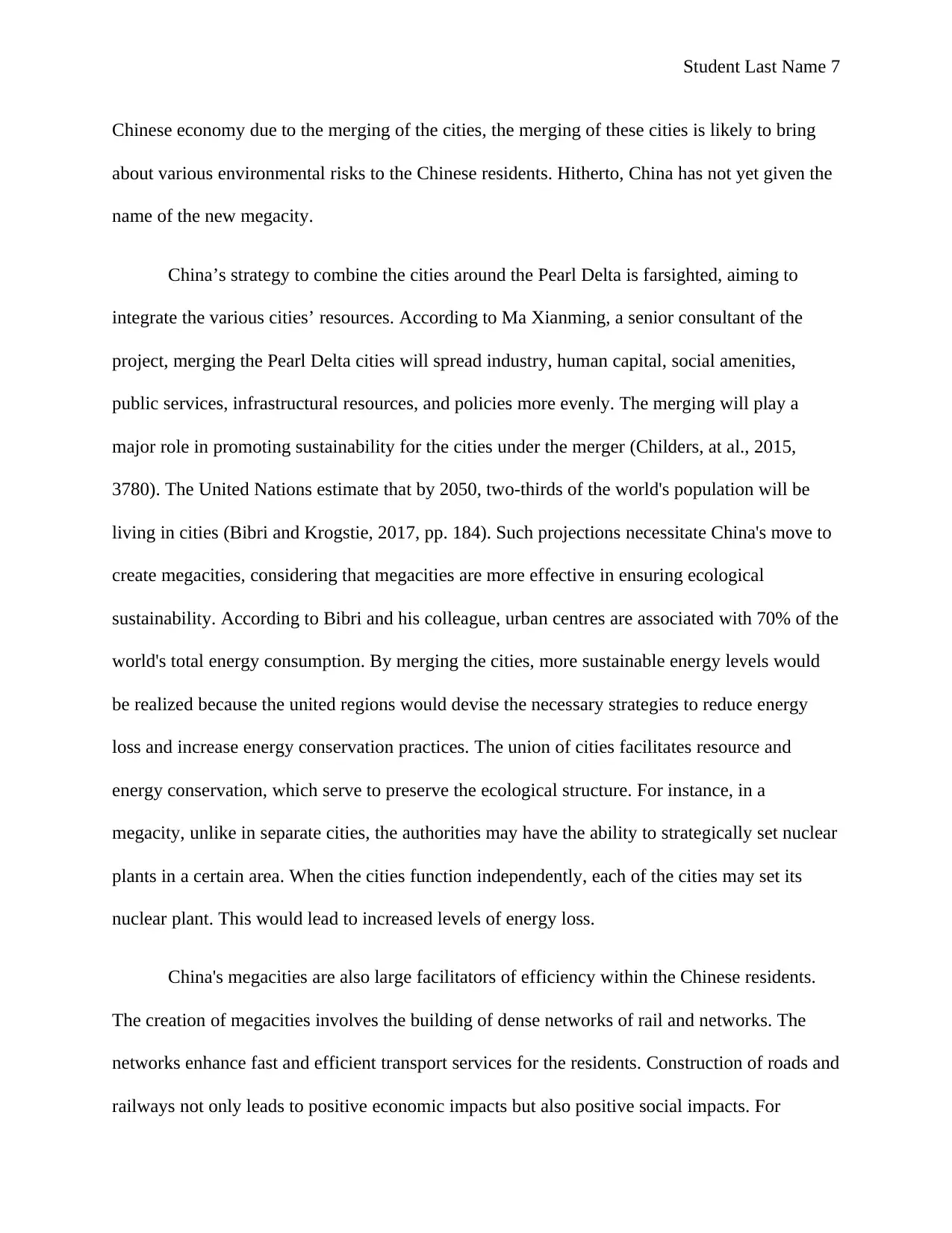
Student Last Name 7
Chinese economy due to the merging of the cities, the merging of these cities is likely to bring
about various environmental risks to the Chinese residents. Hitherto, China has not yet given the
name of the new megacity.
China’s strategy to combine the cities around the Pearl Delta is farsighted, aiming to
integrate the various cities’ resources. According to Ma Xianming, a senior consultant of the
project, merging the Pearl Delta cities will spread industry, human capital, social amenities,
public services, infrastructural resources, and policies more evenly. The merging will play a
major role in promoting sustainability for the cities under the merger (Childers, at al., 2015,
3780). The United Nations estimate that by 2050, two-thirds of the world's population will be
living in cities (Bibri and Krogstie, 2017, pp. 184). Such projections necessitate China's move to
create megacities, considering that megacities are more effective in ensuring ecological
sustainability. According to Bibri and his colleague, urban centres are associated with 70% of the
world's total energy consumption. By merging the cities, more sustainable energy levels would
be realized because the united regions would devise the necessary strategies to reduce energy
loss and increase energy conservation practices. The union of cities facilitates resource and
energy conservation, which serve to preserve the ecological structure. For instance, in a
megacity, unlike in separate cities, the authorities may have the ability to strategically set nuclear
plants in a certain area. When the cities function independently, each of the cities may set its
nuclear plant. This would lead to increased levels of energy loss.
China's megacities are also large facilitators of efficiency within the Chinese residents.
The creation of megacities involves the building of dense networks of rail and networks. The
networks enhance fast and efficient transport services for the residents. Construction of roads and
railways not only leads to positive economic impacts but also positive social impacts. For
Chinese economy due to the merging of the cities, the merging of these cities is likely to bring
about various environmental risks to the Chinese residents. Hitherto, China has not yet given the
name of the new megacity.
China’s strategy to combine the cities around the Pearl Delta is farsighted, aiming to
integrate the various cities’ resources. According to Ma Xianming, a senior consultant of the
project, merging the Pearl Delta cities will spread industry, human capital, social amenities,
public services, infrastructural resources, and policies more evenly. The merging will play a
major role in promoting sustainability for the cities under the merger (Childers, at al., 2015,
3780). The United Nations estimate that by 2050, two-thirds of the world's population will be
living in cities (Bibri and Krogstie, 2017, pp. 184). Such projections necessitate China's move to
create megacities, considering that megacities are more effective in ensuring ecological
sustainability. According to Bibri and his colleague, urban centres are associated with 70% of the
world's total energy consumption. By merging the cities, more sustainable energy levels would
be realized because the united regions would devise the necessary strategies to reduce energy
loss and increase energy conservation practices. The union of cities facilitates resource and
energy conservation, which serve to preserve the ecological structure. For instance, in a
megacity, unlike in separate cities, the authorities may have the ability to strategically set nuclear
plants in a certain area. When the cities function independently, each of the cities may set its
nuclear plant. This would lead to increased levels of energy loss.
China's megacities are also large facilitators of efficiency within the Chinese residents.
The creation of megacities involves the building of dense networks of rail and networks. The
networks enhance fast and efficient transport services for the residents. Construction of roads and
railways not only leads to positive economic impacts but also positive social impacts. For
Paraphrase This Document
Need a fresh take? Get an instant paraphrase of this document with our AI Paraphraser
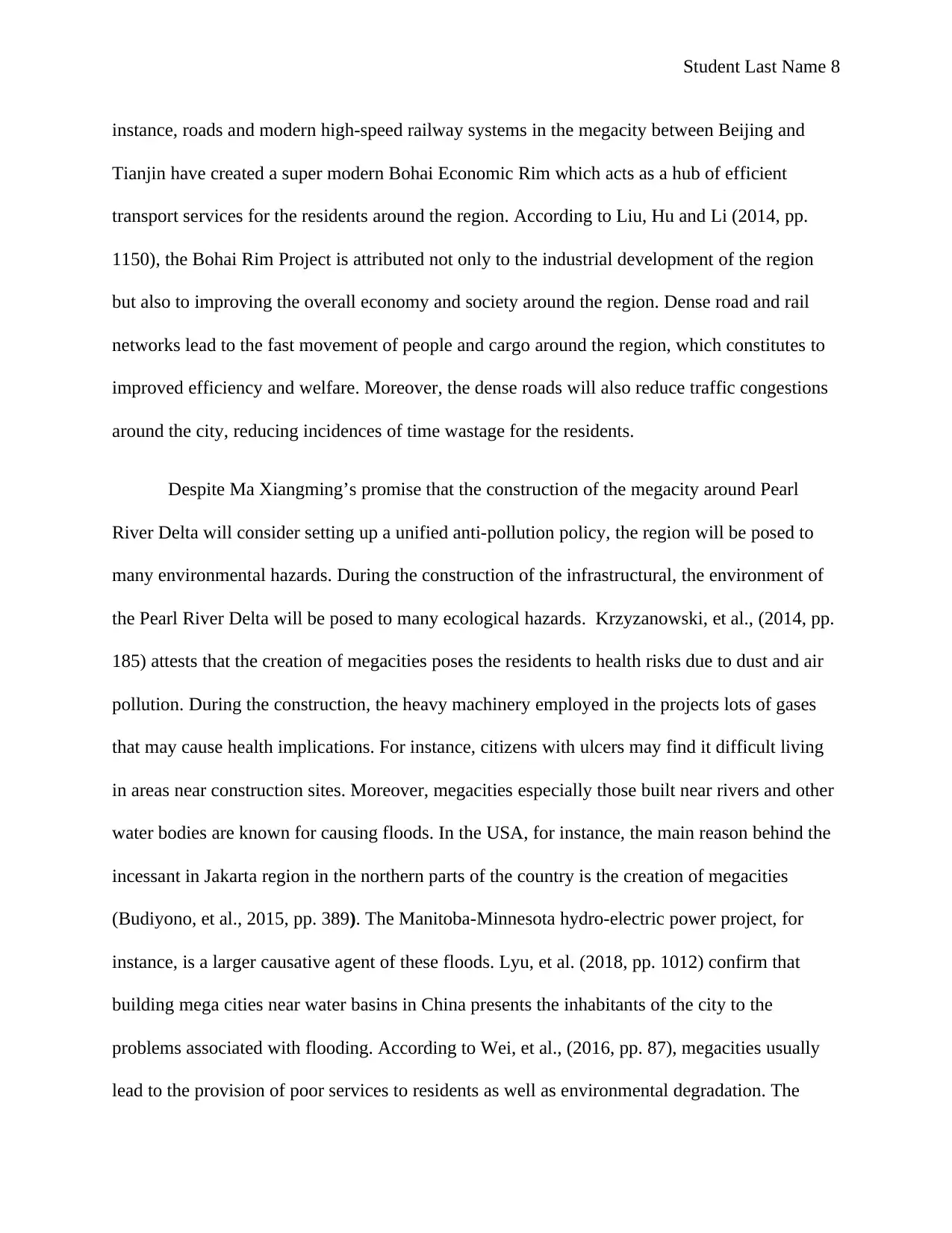
Student Last Name 8
instance, roads and modern high-speed railway systems in the megacity between Beijing and
Tianjin have created a super modern Bohai Economic Rim which acts as a hub of efficient
transport services for the residents around the region. According to Liu, Hu and Li (2014, pp.
1150), the Bohai Rim Project is attributed not only to the industrial development of the region
but also to improving the overall economy and society around the region. Dense road and rail
networks lead to the fast movement of people and cargo around the region, which constitutes to
improved efficiency and welfare. Moreover, the dense roads will also reduce traffic congestions
around the city, reducing incidences of time wastage for the residents.
Despite Ma Xiangming’s promise that the construction of the megacity around Pearl
River Delta will consider setting up a unified anti-pollution policy, the region will be posed to
many environmental hazards. During the construction of the infrastructural, the environment of
the Pearl River Delta will be posed to many ecological hazards. Krzyzanowski, et al., (2014, pp.
185) attests that the creation of megacities poses the residents to health risks due to dust and air
pollution. During the construction, the heavy machinery employed in the projects lots of gases
that may cause health implications. For instance, citizens with ulcers may find it difficult living
in areas near construction sites. Moreover, megacities especially those built near rivers and other
water bodies are known for causing floods. In the USA, for instance, the main reason behind the
incessant in Jakarta region in the northern parts of the country is the creation of megacities
(Budiyono, et al., 2015, pp. 389). The Manitoba-Minnesota hydro-electric power project, for
instance, is a larger causative agent of these floods. Lyu, et al. (2018, pp. 1012) confirm that
building mega cities near water basins in China presents the inhabitants of the city to the
problems associated with flooding. According to Wei, et al., (2016, pp. 87), megacities usually
lead to the provision of poor services to residents as well as environmental degradation. The
instance, roads and modern high-speed railway systems in the megacity between Beijing and
Tianjin have created a super modern Bohai Economic Rim which acts as a hub of efficient
transport services for the residents around the region. According to Liu, Hu and Li (2014, pp.
1150), the Bohai Rim Project is attributed not only to the industrial development of the region
but also to improving the overall economy and society around the region. Dense road and rail
networks lead to the fast movement of people and cargo around the region, which constitutes to
improved efficiency and welfare. Moreover, the dense roads will also reduce traffic congestions
around the city, reducing incidences of time wastage for the residents.
Despite Ma Xiangming’s promise that the construction of the megacity around Pearl
River Delta will consider setting up a unified anti-pollution policy, the region will be posed to
many environmental hazards. During the construction of the infrastructural, the environment of
the Pearl River Delta will be posed to many ecological hazards. Krzyzanowski, et al., (2014, pp.
185) attests that the creation of megacities poses the residents to health risks due to dust and air
pollution. During the construction, the heavy machinery employed in the projects lots of gases
that may cause health implications. For instance, citizens with ulcers may find it difficult living
in areas near construction sites. Moreover, megacities especially those built near rivers and other
water bodies are known for causing floods. In the USA, for instance, the main reason behind the
incessant in Jakarta region in the northern parts of the country is the creation of megacities
(Budiyono, et al., 2015, pp. 389). The Manitoba-Minnesota hydro-electric power project, for
instance, is a larger causative agent of these floods. Lyu, et al. (2018, pp. 1012) confirm that
building mega cities near water basins in China presents the inhabitants of the city to the
problems associated with flooding. According to Wei, et al., (2016, pp. 87), megacities usually
lead to the provision of poor services to residents as well as environmental degradation. The
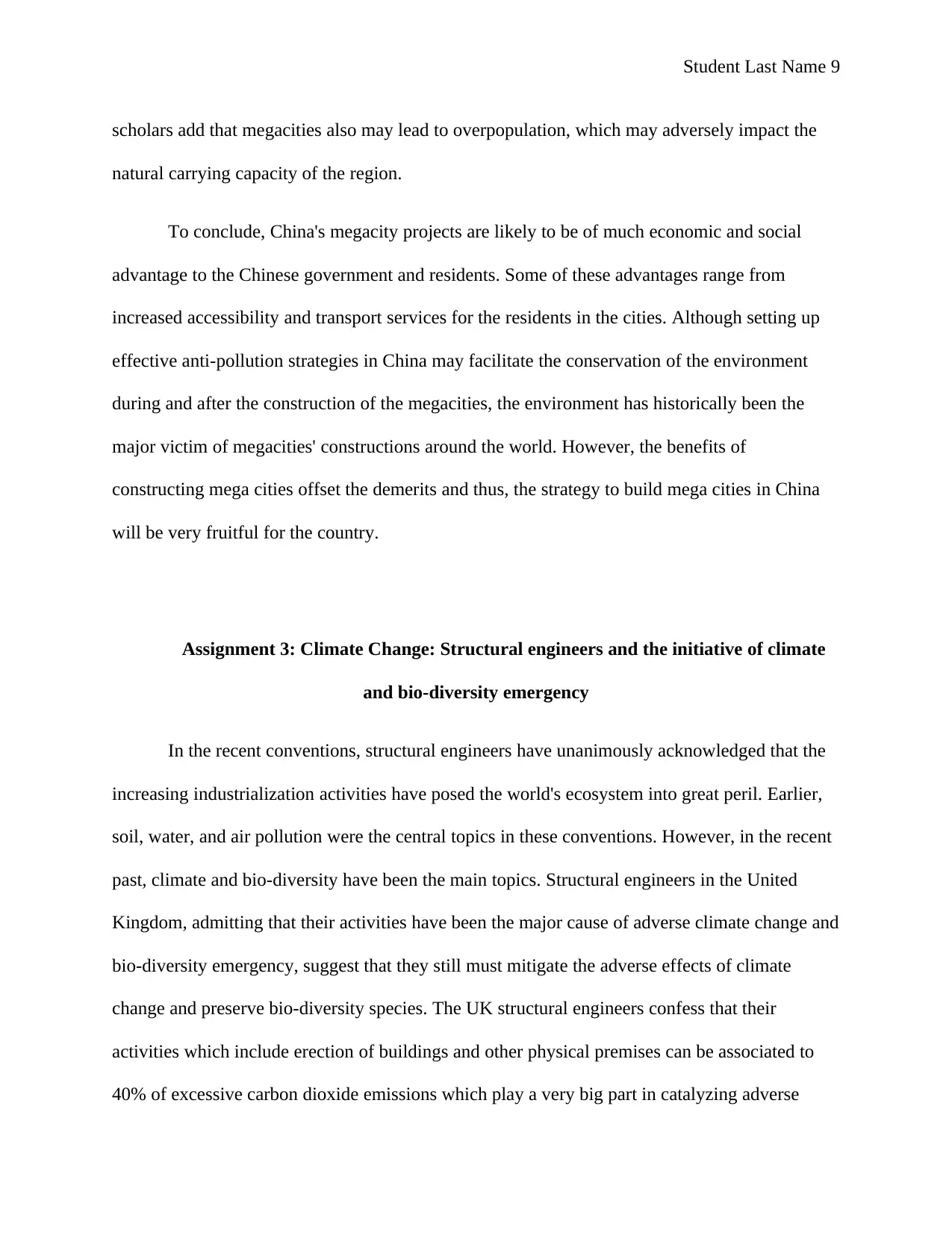
Student Last Name 9
scholars add that megacities also may lead to overpopulation, which may adversely impact the
natural carrying capacity of the region.
To conclude, China's megacity projects are likely to be of much economic and social
advantage to the Chinese government and residents. Some of these advantages range from
increased accessibility and transport services for the residents in the cities. Although setting up
effective anti-pollution strategies in China may facilitate the conservation of the environment
during and after the construction of the megacities, the environment has historically been the
major victim of megacities' constructions around the world. However, the benefits of
constructing mega cities offset the demerits and thus, the strategy to build mega cities in China
will be very fruitful for the country.
Assignment 3: Climate Change: Structural engineers and the initiative of climate
and bio-diversity emergency
In the recent conventions, structural engineers have unanimously acknowledged that the
increasing industrialization activities have posed the world's ecosystem into great peril. Earlier,
soil, water, and air pollution were the central topics in these conventions. However, in the recent
past, climate and bio-diversity have been the main topics. Structural engineers in the United
Kingdom, admitting that their activities have been the major cause of adverse climate change and
bio-diversity emergency, suggest that they still must mitigate the adverse effects of climate
change and preserve bio-diversity species. The UK structural engineers confess that their
activities which include erection of buildings and other physical premises can be associated to
40% of excessive carbon dioxide emissions which play a very big part in catalyzing adverse
scholars add that megacities also may lead to overpopulation, which may adversely impact the
natural carrying capacity of the region.
To conclude, China's megacity projects are likely to be of much economic and social
advantage to the Chinese government and residents. Some of these advantages range from
increased accessibility and transport services for the residents in the cities. Although setting up
effective anti-pollution strategies in China may facilitate the conservation of the environment
during and after the construction of the megacities, the environment has historically been the
major victim of megacities' constructions around the world. However, the benefits of
constructing mega cities offset the demerits and thus, the strategy to build mega cities in China
will be very fruitful for the country.
Assignment 3: Climate Change: Structural engineers and the initiative of climate
and bio-diversity emergency
In the recent conventions, structural engineers have unanimously acknowledged that the
increasing industrialization activities have posed the world's ecosystem into great peril. Earlier,
soil, water, and air pollution were the central topics in these conventions. However, in the recent
past, climate and bio-diversity have been the main topics. Structural engineers in the United
Kingdom, admitting that their activities have been the major cause of adverse climate change and
bio-diversity emergency, suggest that they still must mitigate the adverse effects of climate
change and preserve bio-diversity species. The UK structural engineers confess that their
activities which include erection of buildings and other physical premises can be associated to
40% of excessive carbon dioxide emissions which play a very big part in catalyzing adverse
⊘ This is a preview!⊘
Do you want full access?
Subscribe today to unlock all pages.

Trusted by 1+ million students worldwide
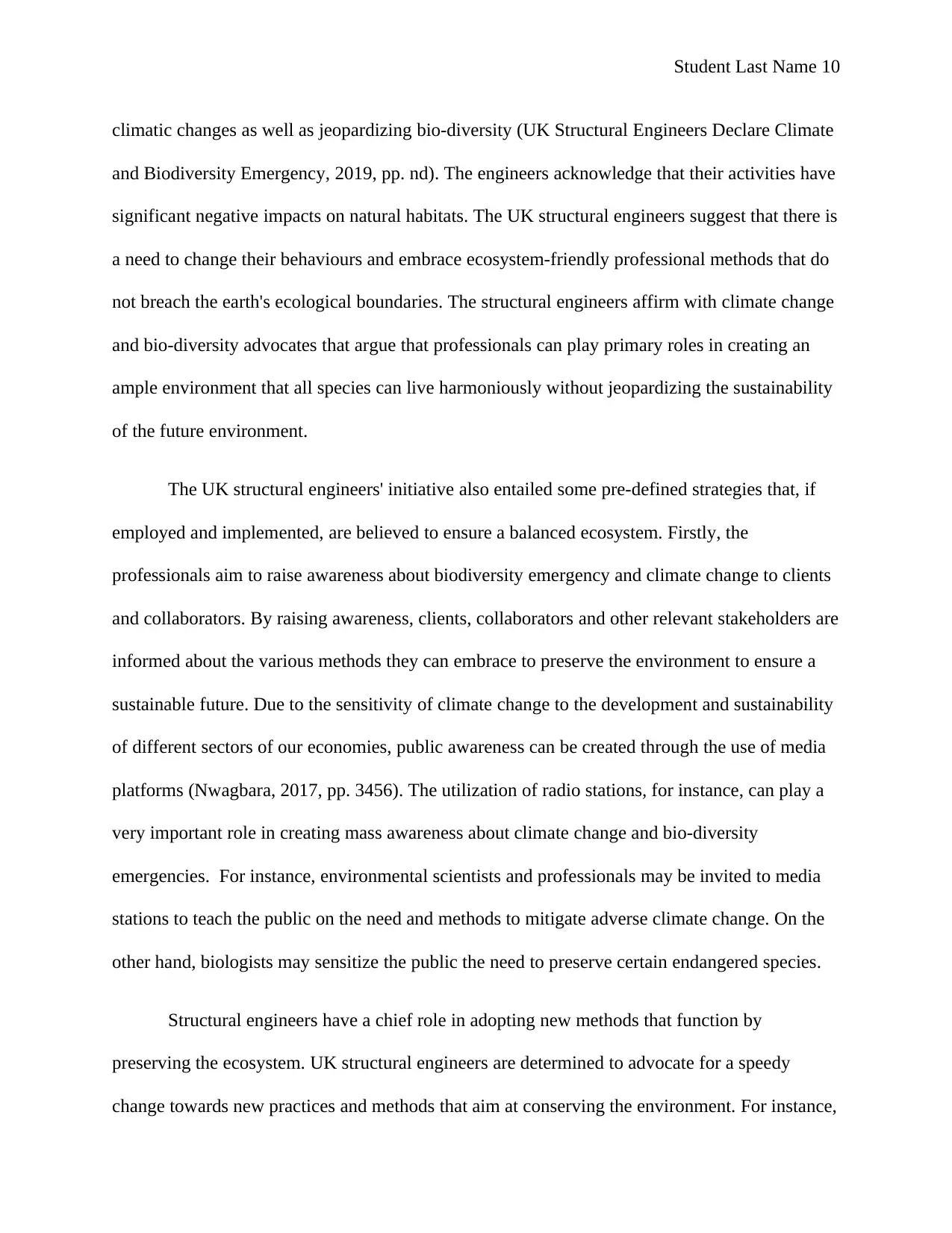
Student Last Name 10
climatic changes as well as jeopardizing bio-diversity (UK Structural Engineers Declare Climate
and Biodiversity Emergency, 2019, pp. nd). The engineers acknowledge that their activities have
significant negative impacts on natural habitats. The UK structural engineers suggest that there is
a need to change their behaviours and embrace ecosystem-friendly professional methods that do
not breach the earth's ecological boundaries. The structural engineers affirm with climate change
and bio-diversity advocates that argue that professionals can play primary roles in creating an
ample environment that all species can live harmoniously without jeopardizing the sustainability
of the future environment.
The UK structural engineers' initiative also entailed some pre-defined strategies that, if
employed and implemented, are believed to ensure a balanced ecosystem. Firstly, the
professionals aim to raise awareness about biodiversity emergency and climate change to clients
and collaborators. By raising awareness, clients, collaborators and other relevant stakeholders are
informed about the various methods they can embrace to preserve the environment to ensure a
sustainable future. Due to the sensitivity of climate change to the development and sustainability
of different sectors of our economies, public awareness can be created through the use of media
platforms (Nwagbara, 2017, pp. 3456). The utilization of radio stations, for instance, can play a
very important role in creating mass awareness about climate change and bio-diversity
emergencies. For instance, environmental scientists and professionals may be invited to media
stations to teach the public on the need and methods to mitigate adverse climate change. On the
other hand, biologists may sensitize the public the need to preserve certain endangered species.
Structural engineers have a chief role in adopting new methods that function by
preserving the ecosystem. UK structural engineers are determined to advocate for a speedy
change towards new practices and methods that aim at conserving the environment. For instance,
climatic changes as well as jeopardizing bio-diversity (UK Structural Engineers Declare Climate
and Biodiversity Emergency, 2019, pp. nd). The engineers acknowledge that their activities have
significant negative impacts on natural habitats. The UK structural engineers suggest that there is
a need to change their behaviours and embrace ecosystem-friendly professional methods that do
not breach the earth's ecological boundaries. The structural engineers affirm with climate change
and bio-diversity advocates that argue that professionals can play primary roles in creating an
ample environment that all species can live harmoniously without jeopardizing the sustainability
of the future environment.
The UK structural engineers' initiative also entailed some pre-defined strategies that, if
employed and implemented, are believed to ensure a balanced ecosystem. Firstly, the
professionals aim to raise awareness about biodiversity emergency and climate change to clients
and collaborators. By raising awareness, clients, collaborators and other relevant stakeholders are
informed about the various methods they can embrace to preserve the environment to ensure a
sustainable future. Due to the sensitivity of climate change to the development and sustainability
of different sectors of our economies, public awareness can be created through the use of media
platforms (Nwagbara, 2017, pp. 3456). The utilization of radio stations, for instance, can play a
very important role in creating mass awareness about climate change and bio-diversity
emergencies. For instance, environmental scientists and professionals may be invited to media
stations to teach the public on the need and methods to mitigate adverse climate change. On the
other hand, biologists may sensitize the public the need to preserve certain endangered species.
Structural engineers have a chief role in adopting new methods that function by
preserving the ecosystem. UK structural engineers are determined to advocate for a speedy
change towards new practices and methods that aim at conserving the environment. For instance,
Paraphrase This Document
Need a fresh take? Get an instant paraphrase of this document with our AI Paraphraser
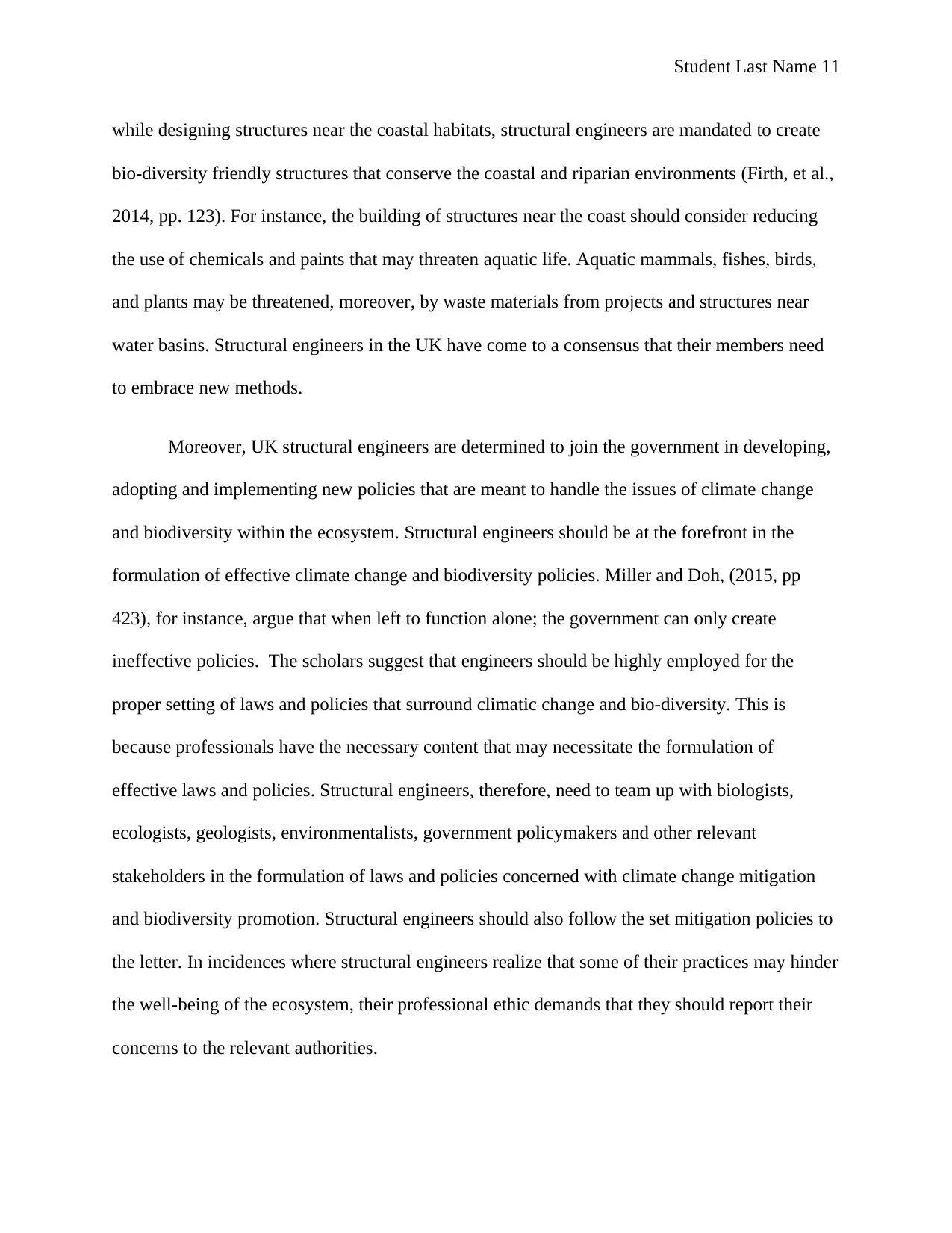
Student Last Name 11
while designing structures near the coastal habitats, structural engineers are mandated to create
bio-diversity friendly structures that conserve the coastal and riparian environments (Firth, et al.,
2014, pp. 123). For instance, the building of structures near the coast should consider reducing
the use of chemicals and paints that may threaten aquatic life. Aquatic mammals, fishes, birds,
and plants may be threatened, moreover, by waste materials from projects and structures near
water basins. Structural engineers in the UK have come to a consensus that their members need
to embrace new methods.
Moreover, UK structural engineers are determined to join the government in developing,
adopting and implementing new policies that are meant to handle the issues of climate change
and biodiversity within the ecosystem. Structural engineers should be at the forefront in the
formulation of effective climate change and biodiversity policies. Miller and Doh, (2015, pp
423), for instance, argue that when left to function alone; the government can only create
ineffective policies. The scholars suggest that engineers should be highly employed for the
proper setting of laws and policies that surround climatic change and bio-diversity. This is
because professionals have the necessary content that may necessitate the formulation of
effective laws and policies. Structural engineers, therefore, need to team up with biologists,
ecologists, geologists, environmentalists, government policymakers and other relevant
stakeholders in the formulation of laws and policies concerned with climate change mitigation
and biodiversity promotion. Structural engineers should also follow the set mitigation policies to
the letter. In incidences where structural engineers realize that some of their practices may hinder
the well-being of the ecosystem, their professional ethic demands that they should report their
concerns to the relevant authorities.
while designing structures near the coastal habitats, structural engineers are mandated to create
bio-diversity friendly structures that conserve the coastal and riparian environments (Firth, et al.,
2014, pp. 123). For instance, the building of structures near the coast should consider reducing
the use of chemicals and paints that may threaten aquatic life. Aquatic mammals, fishes, birds,
and plants may be threatened, moreover, by waste materials from projects and structures near
water basins. Structural engineers in the UK have come to a consensus that their members need
to embrace new methods.
Moreover, UK structural engineers are determined to join the government in developing,
adopting and implementing new policies that are meant to handle the issues of climate change
and biodiversity within the ecosystem. Structural engineers should be at the forefront in the
formulation of effective climate change and biodiversity policies. Miller and Doh, (2015, pp
423), for instance, argue that when left to function alone; the government can only create
ineffective policies. The scholars suggest that engineers should be highly employed for the
proper setting of laws and policies that surround climatic change and bio-diversity. This is
because professionals have the necessary content that may necessitate the formulation of
effective laws and policies. Structural engineers, therefore, need to team up with biologists,
ecologists, geologists, environmentalists, government policymakers and other relevant
stakeholders in the formulation of laws and policies concerned with climate change mitigation
and biodiversity promotion. Structural engineers should also follow the set mitigation policies to
the letter. In incidences where structural engineers realize that some of their practices may hinder
the well-being of the ecosystem, their professional ethic demands that they should report their
concerns to the relevant authorities.
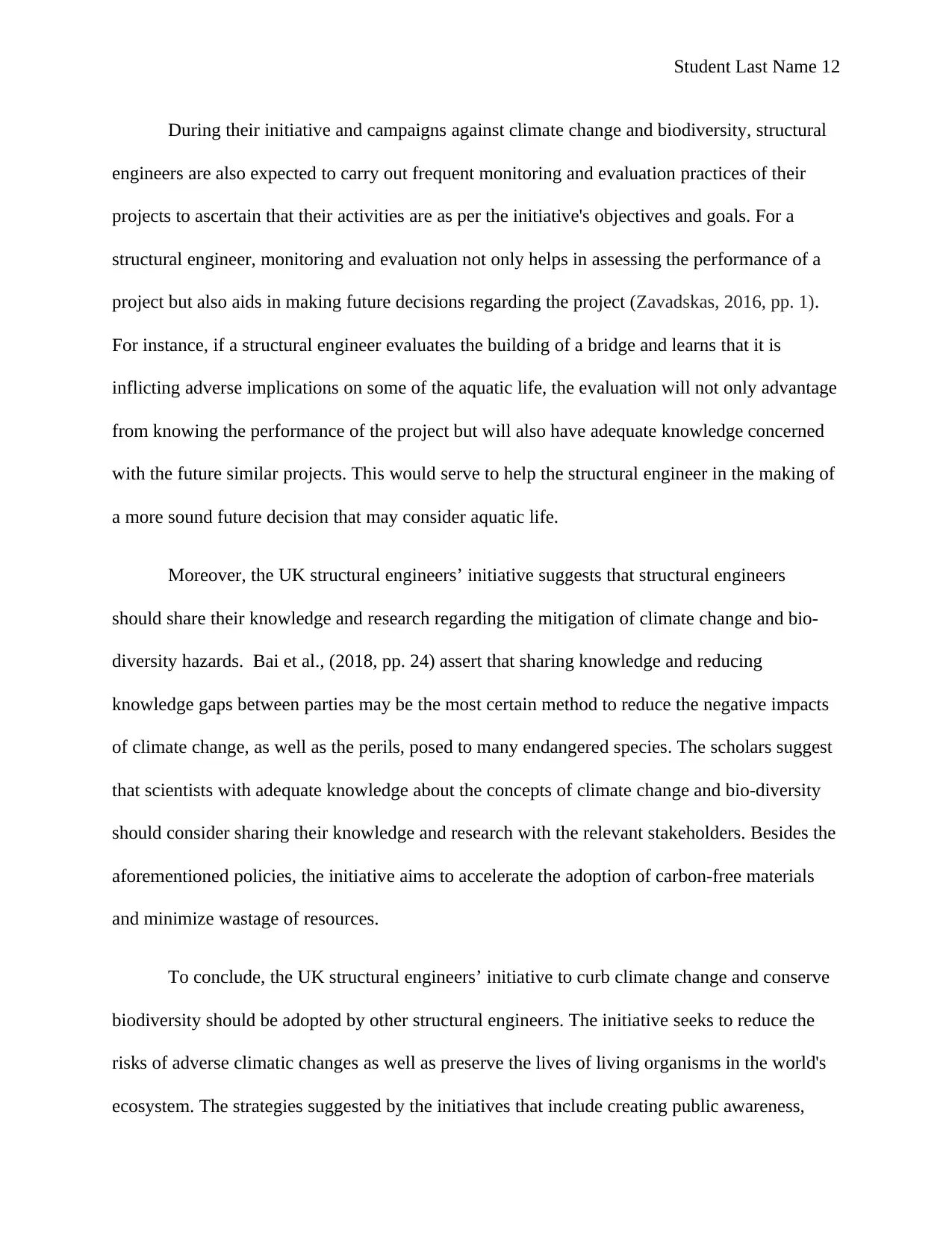
Student Last Name 12
During their initiative and campaigns against climate change and biodiversity, structural
engineers are also expected to carry out frequent monitoring and evaluation practices of their
projects to ascertain that their activities are as per the initiative's objectives and goals. For a
structural engineer, monitoring and evaluation not only helps in assessing the performance of a
project but also aids in making future decisions regarding the project (Zavadskas, 2016, pp. 1).
For instance, if a structural engineer evaluates the building of a bridge and learns that it is
inflicting adverse implications on some of the aquatic life, the evaluation will not only advantage
from knowing the performance of the project but will also have adequate knowledge concerned
with the future similar projects. This would serve to help the structural engineer in the making of
a more sound future decision that may consider aquatic life.
Moreover, the UK structural engineers’ initiative suggests that structural engineers
should share their knowledge and research regarding the mitigation of climate change and bio-
diversity hazards. Bai et al., (2018, pp. 24) assert that sharing knowledge and reducing
knowledge gaps between parties may be the most certain method to reduce the negative impacts
of climate change, as well as the perils, posed to many endangered species. The scholars suggest
that scientists with adequate knowledge about the concepts of climate change and bio-diversity
should consider sharing their knowledge and research with the relevant stakeholders. Besides the
aforementioned policies, the initiative aims to accelerate the adoption of carbon-free materials
and minimize wastage of resources.
To conclude, the UK structural engineers’ initiative to curb climate change and conserve
biodiversity should be adopted by other structural engineers. The initiative seeks to reduce the
risks of adverse climatic changes as well as preserve the lives of living organisms in the world's
ecosystem. The strategies suggested by the initiatives that include creating public awareness,
During their initiative and campaigns against climate change and biodiversity, structural
engineers are also expected to carry out frequent monitoring and evaluation practices of their
projects to ascertain that their activities are as per the initiative's objectives and goals. For a
structural engineer, monitoring and evaluation not only helps in assessing the performance of a
project but also aids in making future decisions regarding the project (Zavadskas, 2016, pp. 1).
For instance, if a structural engineer evaluates the building of a bridge and learns that it is
inflicting adverse implications on some of the aquatic life, the evaluation will not only advantage
from knowing the performance of the project but will also have adequate knowledge concerned
with the future similar projects. This would serve to help the structural engineer in the making of
a more sound future decision that may consider aquatic life.
Moreover, the UK structural engineers’ initiative suggests that structural engineers
should share their knowledge and research regarding the mitigation of climate change and bio-
diversity hazards. Bai et al., (2018, pp. 24) assert that sharing knowledge and reducing
knowledge gaps between parties may be the most certain method to reduce the negative impacts
of climate change, as well as the perils, posed to many endangered species. The scholars suggest
that scientists with adequate knowledge about the concepts of climate change and bio-diversity
should consider sharing their knowledge and research with the relevant stakeholders. Besides the
aforementioned policies, the initiative aims to accelerate the adoption of carbon-free materials
and minimize wastage of resources.
To conclude, the UK structural engineers’ initiative to curb climate change and conserve
biodiversity should be adopted by other structural engineers. The initiative seeks to reduce the
risks of adverse climatic changes as well as preserve the lives of living organisms in the world's
ecosystem. The strategies suggested by the initiatives that include creating public awareness,
⊘ This is a preview!⊘
Do you want full access?
Subscribe today to unlock all pages.

Trusted by 1+ million students worldwide
1 out of 17
Related Documents
Your All-in-One AI-Powered Toolkit for Academic Success.
+13062052269
info@desklib.com
Available 24*7 on WhatsApp / Email
![[object Object]](/_next/static/media/star-bottom.7253800d.svg)
Unlock your academic potential
Copyright © 2020–2025 A2Z Services. All Rights Reserved. Developed and managed by ZUCOL.





